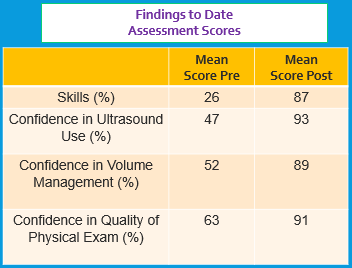Background: Point-of-care ultrasound (POCUS) is being used to support the diagnosis and serially monitor patients with and without COVID-19. There have been concerns about use of personal protective equipment, the ability to receive hands-on supervision and support for interpretations of ultrasound in this era. Efforts to expand POCUS educational initiatives have been hindered by insufficient clinical supervision due to a lack of available POCUS training teaching faculty. Some ultrasound manufacturers have added tele-ultrasound software that allows remote training of novice POCUS users and remote guidance in actual patient care. Tele-ultrasound can be utilized to share images in real time and support with training. No guidelines exist to train residents and medical students on POCUS virtually or to supplement traditional in-person training.
Purpose: We aimed to provide a supplemental virtual training program to traditional in-person hands-on ultrasound education during an internal medicine rotation to improve skills and confidence levels across a broad range of diagnostic ultrasound skills. Five handheld ultrasound devices were obtained with tele-ultrasound features and were available for attending physicians supervising residents and medical students rotating on hospital medicine services to train during internal medicine rotations.
Description: The innovation seeks to provide an ultrasound training program that combines in-person hands on training and supplemental virtual ultrasound training for learners. The following are the curricular components during an internal medicine rotation:1) Pre-assessment to assess confidence & skills.*2) Focused development involving five core cardio-pulmonary views (Cardiac Long Axis, Subxiphoid Long Axis, Pulmonary A/B lines, Pleural Effusion, Inferior Vena Cava). Learners participated in a “Flipped classroom” with videos (five min recordings on core views). The hands-on component was completed with in-person supervision supplemented by tele-ultrasound sessions.3) Post-assessment to assess confidence & skills.*11 total learners (medical students and residents) participated in the pilot phase of this program from May-September, 2020. A total of 50 hands-on training sessions were completed with 23 (46%) in-person hands-on training encounters and 27 (54%) virtual training sessions. Learners reported increased knowledge of POCUS indications, comfort performing POCUS, and augmenting their physical exam. Mean skills and confidence scores for learners also improved. Assessment scores are provided in the supplemental figure. Both before and after training, learners overwhelmingly agreed with statements that ultrasound would improve their diagnosis in the care of hospitalized patients. 82% (n=9) stated that the virtual hands-on training was as or more effective than the 100% in-person format for ultrasound training.*Assessments were based off of the CHAMP US Program (See Reference Section)
Conclusions: The ability to use tele-ultrasound to remotely supervise, train and guide a learner is a key tool to provide virtual training that supplements the in-person experience. The program improved skills and confidence levels across a broad range of diagnostic ultrasound skills.Further follow up of this pilot project is planned to explore longitudinal training throughout rotations, examining changes in rotation evaluations, and diary sampling of ward teams with the expanded role that faculty now have with tele-ultrasound capabilities.

